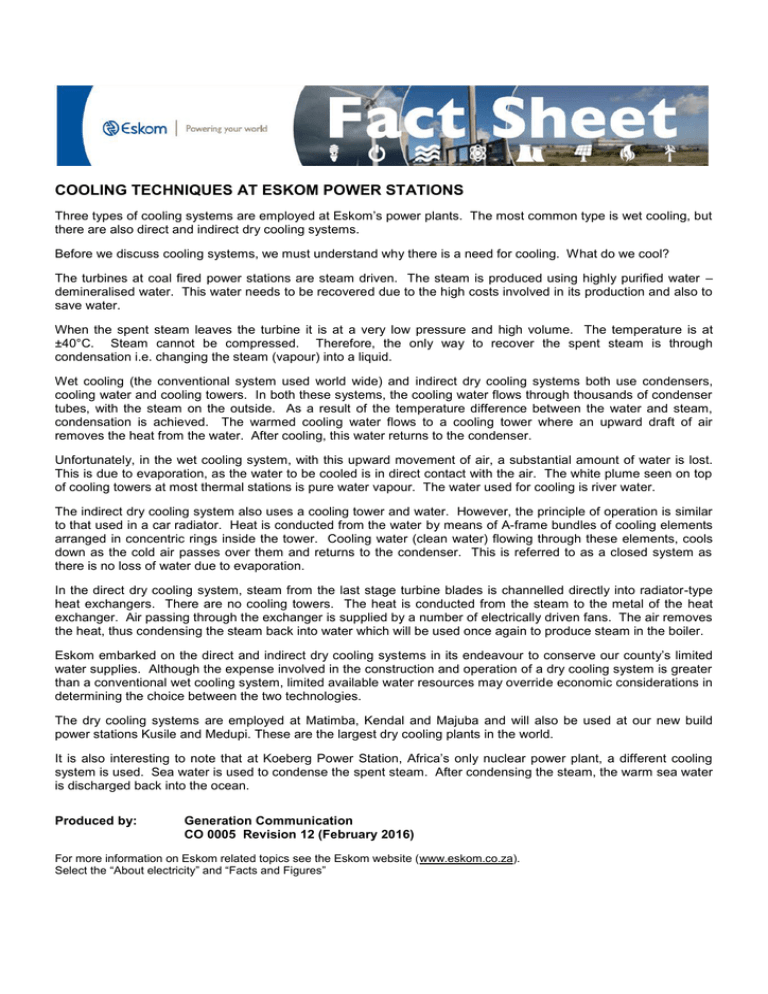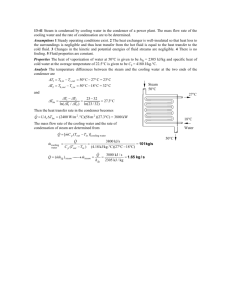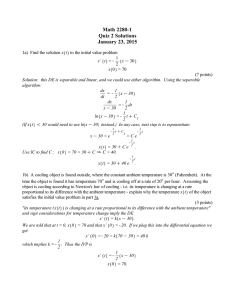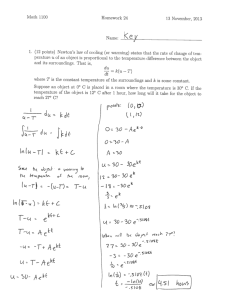COOLING TECHNIQUES AT ESKOM POWER STATIONS
advertisement

COOLING TECHNIQUES AT ESKOM POWER STATIONS Three types of cooling systems are employed at Eskom’s power plants. The most common type is wet cooling, but there are also direct and indirect dry cooling systems. Before we discuss cooling systems, we must understand why there is a need for cooling. What do we cool? The turbines at coal fired power stations are steam driven. The steam is produced using highly purified water – demineralised water. This water needs to be recovered due to the high costs involved in its production and also to save water. When the spent steam leaves the turbine it is at a very low pressure and high volume. The temperature is at ±40°C. Steam cannot be compressed. Therefore, the only way to recover the spent steam is through condensation i.e. changing the steam (vapour) into a liquid. Wet cooling (the conventional system used world wide) and indirect dry cooling systems both use condensers, cooling water and cooling towers. In both these systems, the cooling water flows through thousands of condenser tubes, with the steam on the outside. As a result of the temperature difference between the water and steam, condensation is achieved. The warmed cooling water flows to a cooling tower where an upward draft of air removes the heat from the water. After cooling, this water returns to the condenser. Unfortunately, in the wet cooling system, with this upward movement of air, a substantial amount of water is lost. This is due to evaporation, as the water to be cooled is in direct contact with the air. The white plume seen on top of cooling towers at most thermal stations is pure water vapour. The water used for cooling is river water. The indirect dry cooling system also uses a cooling tower and water. However, the principle of operation is similar to that used in a car radiator. Heat is conducted from the water by means of A-frame bundles of cooling elements arranged in concentric rings inside the tower. Cooling water (clean water) flowing through these elements, cools down as the cold air passes over them and returns to the condenser. This is referred to as a closed system as there is no loss of water due to evaporation. In the direct dry cooling system, steam from the last stage turbine blades is channelled directly into radiator-type heat exchangers. There are no cooling towers. The heat is conducted from the steam to the metal of the heat exchanger. Air passing through the exchanger is supplied by a number of electrically driven fans. The air removes the heat, thus condensing the steam back into water which will be used once again to produce steam in the boiler. Eskom embarked on the direct and indirect dry cooling systems in its endeavour to conserve our county’s limited water supplies. Although the expense involved in the construction and operation of a dry cooling system is greater than a conventional wet cooling system, limited available water resources may override economic considerations in determining the choice between the two technologies. The dry cooling systems are employed at Matimba, Kendal and Majuba and will also be used at our new build power stations Kusile and Medupi. These are the largest dry cooling plants in the world. It is also interesting to note that at Koeberg Power Station, Africa’s only nuclear power plant, a different cooling system is used. Sea water is used to condense the spent steam. After condensing the steam, the warm sea water is discharged back into the ocean. Produced by: Generation Communication CO 0005 Revision 12 (February 2016) For more information on Eskom related topics see the Eskom website (www.eskom.co.za). Select the “About electricity” and “Facts and Figures”





